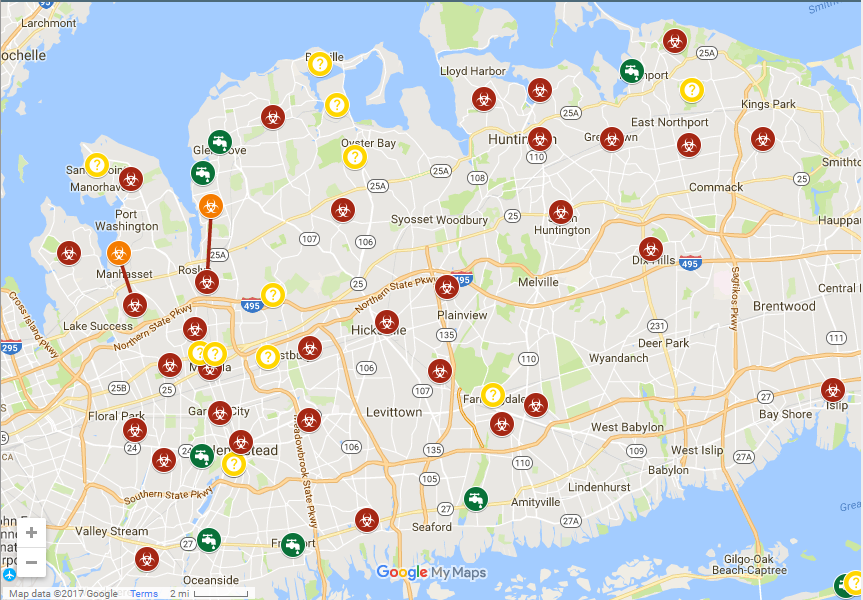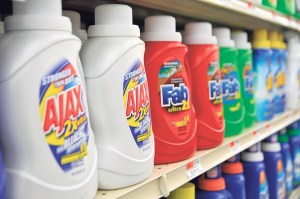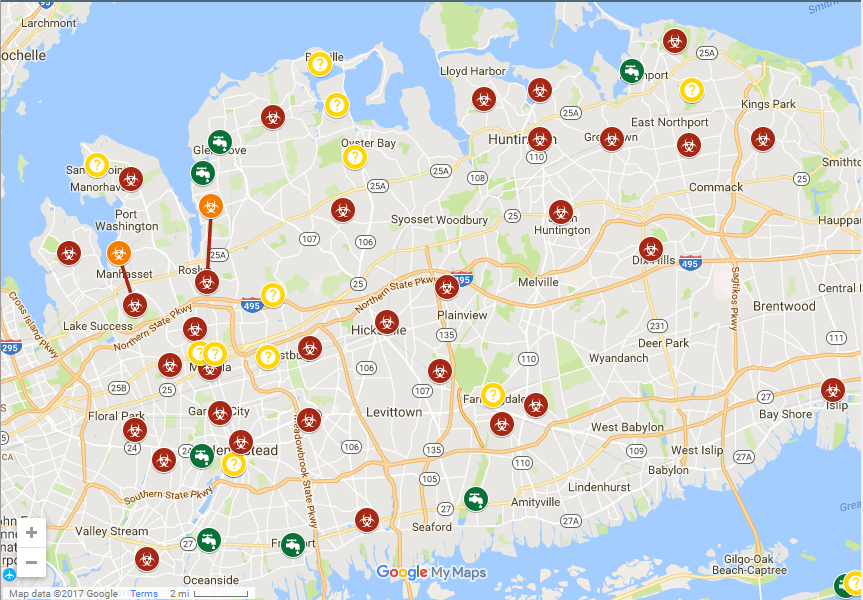Group warns against toxins in drinking water

A report by the Farmingdale-based Citizens Campaign for the Environment (CCE) reveals elevated levels of a possible carcinogen in water districts throughout Long Island.
Found in various personal-care products, the cancer-causing chemical, 1,4-dioxane, is listed as “likely to be carcinogenic to humans” by the Environmental Protection Agency (EPA). And according to CCE, Long Islander water supplies have the highest levels of 1,4-dioxane in the nation.
In response to the findings, the group has devised an interactive map at www.citizenscampaign.org/campaigns.dioxane.asp so that residents can investigate contamination levels in their local groundwater.
According to the map, 1,4-dioxane was detected in levels above the EPA’s cancer risk guideline in the Manhasset-Lakeville Water District (MLWD), which has 14 wells serving a population of about 43,000 in Manhasset, Plandome Heights, Munsey Park, University Gardens, Lake Success, half of Great Neck Plaza, North Hills, Plandome Manor, part of Flower Hill, Manhasset Hills and North New Hyde Park.
Superintendent Paul Schraeder of MLWD stated “The Manhasset-Lakeville Water District’s 2015 Annual Water Quality Report included results for 1,4-Dioxane under detected contaminants for the Unregulated Contaminant Monitoring Rule (UCMR). The current NYSDOH guideline for dioxane in drinking water permits up to 50 parts per billion (ppb) (unspecified organic contaminant). The World Health Organization guideline for dioxane is also 50 ppb.”

“The Manhasset-Lakeville Water District’s detection levels for dioxane were non-detect to 1.4 ppb, with an average of 0.33 ppb. Our Lloyd wells are all non-detect, all other wells are less than 1 ppb with the exception of one (1.4ppb), which the district has re-sampled, even though the result was far below the NYSDOH and WHO guidelines; we await the results. Based on the NYSDOH and WHO guidelines, we believe our supply is safe for human health.”
“One thing that every Long Islander can do is avoid products containing dioxane,” CCE said in a statement. “While dioxane itself is not listed on the label, it occurs as a byproduct of processing certain ingredients, and those ingredients are often listed.”
Two of the most common at-risk ingredients are “sodium laureth sulfate” and “potassium laureth phosphate.” Other commonly used ingredients associated with 1,4-dioxane contamination include PEG, polyethylene, polyethylene glycol, polyoxyethylene, myreth, oleth, laureth and ceteareth. Other than these, look for any ingredients with “-eth” or “-oxynol” in their names.
“The Dioxane in our supply is a degradation by product of Tetrachloroethene and/or Trichloroethene, which are both regulated Volatile Organic Compounds (VOC’s) removed with conventional treatment techniques,” said Schraeder. “Dioxane was used as a stabilizer for these and other VOC’s.”
Dioxane gets into the water through products that contain it, including laundry detergent, soap, shampoo and body wash, according to CCE’s report. That report reveals that up to 46 percent of personal-care products contain the chemical, which is not added to consumer goods but rather is an unwanted byproduct of ethoxylation—a process used to reduce skin irritation caused by petroleum-based ingredients. Once in the groundwater and soil, the report stated, it is hard to remove and known as a “legacy” pollution—pollution left behind from past industrial activities—and is also a source of dioxane contamination.
“Human exposure to dioxane is not limited to water. Personal care products, pharmaceuticals, and food supplies may contain dioxane, and may do so at much higher levels than in our water supply. Inhalation is another exposure route, so showering with products that contain dioxane is also a concern,” said Schraeder. “The federal EPA’s UCMR program for emerging contaminants is the first step for the EPA in the regulating process. To date neither the EPA nor NYSDOH have issued a specific drinking water standard for Dioxane”.
“Presently, conventional treatment methods for VOC’s are ineffective for the removal of Dioxane,” added Schraeder. “There are several pilot programs underway, including one being conducted by the Suffolk County Water Authority, that are using an advanced oxidation process (a chemical reaction) to remove dioxane. We anticipate that, if those programs are successful, the DOH will approve that treatment technology for public water suppliers.”
“While avoiding products in our personal lives is a good first step, we need New York state to act now to prevent further exposure to dioxane through our drinking water,” CCE said. “Right now, there is no federal health-based drinking water standard for dioxane, even though the EPA considers ingestion from drinking water to be the most dangerous route of exposure for dioxane.”
To that end, senators Kirsten Gillibrand and Chuck Schumer recently announced legislation that would require the EPA to develop a maximum contaminate level for 1,4-dioxane and other hazardous chemicals in public water systems. As 1,4-dioxane is currently unregulated in the Safe Water Drinking Act, this legislation would require the EPA to create safety guidelines and determine legally enforceable standards that apply to water systems.
“We’ve seen very clearly how much damage can happen to our local drinking water supplies when toxic chemicals like PFOA, PFOS, 1,4-dioxane, and perchlorate aren’t monitored by the EPA,” said Gillibrand, a member of the Senate Environment and Public Works Committee. “New Yorkers should be able to drink water without having to worry about whether it’s safe. Anything less than that standard is unacceptable.”
In January, Schumer and Gillibrand called on the EPA to prioritize and accelerate the risk evaluation for 1,4-dioxane. Schumer also urged Saint-Gobain Performance Plastics to work proactively with federal and state environmental officials to define and clean up another contamination in Hoosick Falls, NY.
“With the recent incidents of contaminated drinking water in New York, it’s crystal clear that we need a maximum contaminant level set by the EPA for perfluorinated compounds like PFOA/PFOS, 1,4-dioxane and perchlorate,” said Schumer. “I will use every ounce of my clout to work with my colleagues in the Senate and make sure this common sense public health bill to ensure safe drinking water is passed.”
There is a link to additional information on 1,4 Dioxane on the M-LWD website at www.mlwd.net, which includes the WHO report.
—Elizabeth Johnson contributed to the story.



































